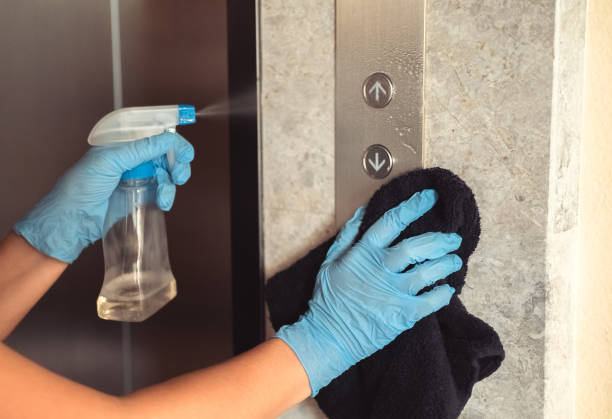In today’s world, maintaining hygiene in high-traffic spaces is more important than ever, and elevators are no exception. As enclosed spaces frequently touched by dozens (or hundreds) of people each day, elevators can become hotspots for germs, bacteria, and viruses if not properly maintained.
In this ultimate guide, you’ll discover a comprehensive, step-by-step elevator cleaning checklist to ensure a sparkling, safe, and germ-free ride for all occupants.
Chapter 1: Why Elevator Cleaning Matters
Elevators are confined, high-touch environments. Without proper cleaning and disinfection, they become breeding grounds for pathogens. Here’s why consistent elevator cleaning is crucial:
- Public Health: Prevent the spread of diseases like COVID-19, influenza, and the common cold.
- First Impressions: Elevators often create the first impression of a building’s cleanliness and professionalism.
- Compliance: Adhering to health and safety regulations can protect businesses from legal issues.
- Maintenance: Regular cleaning extends the life of elevator components like buttons, panels, and flooring.

Chapter 2: Understanding Elevator Hotspots
Before jumping into the checklist, know where germs love to hide:
- Button panels (inside and outside)
- Handrails
- Doors and door frames
- Flooring
- Walls and mirrors
- Ceiling vents and lights
Focusing on these areas ensures a thorough clean every time.
Chapter 3: Supplies You’ll Need
Gather your supplies before starting:
- Microfiber cloths (preferably color-coded for different areas)
- Hospital-grade disinfectant sprays and wipes
- Glass cleaner
- Stainless steel cleaner
- Disposable gloves
- Masks (optional but recommended)
- Vacuum cleaner with attachments
- Floor mop or scrubber
- Trash bags
Chapter 4: Daily Elevator Cleaning Checklist
(Approximate Time: 10–15 minutes per elevator)
1. Prepare and Protect Yourself
- Wear disposable gloves and a mask.
- Ensure signage is posted if elevator use is temporarily restricted during cleaning.
2. Button Panels
- Wipe down buttons with disinfectant wipes.
- Pay special attention to the emergency call button.
3. Handrails
- Disinfect thoroughly.
- Use a fresh cloth or wipe to prevent cross-contamination.
4. Doors and Frames
- Clean both interior and exterior sides of the doors.
- Focus on edges where hands often touch.
5. Mirrors and Glass Surfaces
- Use glass cleaner for streak-free results.
- Buff dry with a clean microfiber cloth.
6. Flooring
- Vacuum or sweep.
- Spot mop spills or sticky residue with disinfectant solution.
7. Air Vents and Lighting Fixtures
- Dust with a microfiber cloth weekly; inspect daily for buildup.
8. Final Check
- Ensure no residue or streaks remain.
- Safely dispose of gloves and cleaning materials.
Chapter 5: Weekly Deep Cleaning Checklist
(Approximate Time: 30–45 minutes per elevator)
In addition to daily cleaning:
1. Detailed Wall Cleaning
- Wipe down all wall surfaces.
- Remove fingerprints, smudges, and scuff marks.
2. Deep Clean Door Tracks
- Vacuum dirt and debris from door tracks.
- Wipe with disinfectant.
3. Edge-to-Edge Floor Mopping
- Use a disinfectant floor cleaner.
- Mop carefully around the elevator edges and corners.
4. Check for Repairs
- Look for damaged buttons, cracked panels, or malfunctioning lights.
Chapter 6: Monthly Elevator Cleaning and Maintenance Routine
(Approximate Time: 60–90 minutes per elevator)
On a monthly basis, perform:
1. Full Vent and Ceiling Cleaning
- Remove vent covers if accessible.
- Vacuum or wipe clean.
- Dust light fixtures and polish if needed.
2. Inspect and Clean Stainless Steel
- Use a stainless-steel cleaner for all metallic surfaces.
- Wipe along the grain for a professional finish.
3. Treat and Protect Flooring
- Apply polish or protective sealants if flooring materials allow.
4. Full Disinfection Fogging (Optional)
- Consider electrostatic fogging for deep sanitization.
Chapter 7: Best Practices for Elevator Cleaning
1. Choose the Right Disinfectants
- Use EPA-approved disinfectants effective against bacteria and viruses.
2. Avoid Overwetting Controls
- Excess liquid can damage electrical components.
3. Rotate Cleaning Cloths
- Change cloths frequently to avoid cross-contamination.
4. Post Cleaning Certificates
- Display notices that elevators are sanitized regularly.
5. Train Staff Thoroughly
- Ensure cleaning teams understand procedures and safety protocols.
Chapter 8: Common Mistakes to Avoid
- Skipping button panels (the dirtiest spot!)
- Using the wrong cleaner (which can damage materials)
- Ignoring corners and edges (where grime accumulates)
- Not wearing gloves during cleaning
- Not ventilating the elevator during and after cleaning
Chapter 9: Special Considerations
High-Traffic Buildings
- Increase cleaning frequency (morning, midday, evening).
Healthcare Facilities
- Follow stricter disinfection protocols (after every few uses if possible).
Residential Buildings
- Schedule visible cleaning sessions to reassure tenants.
Chapter 10: How Technology Can Help
UV Disinfection Systems
- Install UV-C lights that sanitize air between rides.
Antimicrobial Coatings
- Apply protective films or coatings on button panels.
Smart Cleaning Robots
- Some commercial buildings now use autonomous cleaning robots for elevators.
Chapter 11: Elevator Cleaning During and After COVID-19
Pandemics demand an even higher cleaning standard.
- Clean and disinfect multiple times a day.
- Emphasize air quality management.
- Offer hand sanitizer stations near elevators.
Chapter 12: Elevator Cleaning FAQ
Q: How often should elevators be cleaned?
A: At least once daily, with deeper cleaning weekly and monthly.
Q: What is the dirtiest part of an elevator?
A: Button panels and handrails.
Q: Can harsh chemicals damage elevators?
A: Yes. Use manufacturer-recommended products to avoid corrosion.
Q: Should elevators be cleaned during working hours?
A: It’s better to clean early morning, late night, or during low-traffic periods.
Chapter 13: Elevator Cleaning Templates
Consider creating printed checklists for your staff:
- Daily Cleaning Log
- Weekly Deep Cleaning Checklist
- Monthly Maintenance and Cleaning Audit
(Checklists would include spaces for date, time, tasks completed, and staff initials.)
Conclusion: Your Action Plan for a Germ-Free Ride
Keeping elevators clean is not just about appearances—it’s about protecting public health, maintaining building credibility, and enhancing overall user experience.
Follow this detailed checklist:
- Clean surfaces daily
- Disinfect thoroughly
- Maintain deep cleaning schedules
- Train your cleaning teams
- Monitor and adapt based on traffic and events
